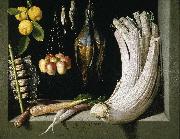Porslinet engros- Olja måleriet Engros- Måleriet Porslinet |
|||||||||||

|
|||||||||||
|
|
|
||||||||||||||
|
Juan Sanchez Cotan
(June 25, 1560 - September 8, 1627) was a Spanish Baroque painter, a pioneer of realism in Spain. His still lifes, also called bodegones were painted in a strikingly austere style, especially when compared to similar works in Netherlands and Italy. Senchez Coten was born in the town of Orgaz, near Toledo, Spain. He was a friend and perhaps pupil of Blas de Prado, an artist famous for his still lifes whose mannerist style with touches of realism, the disciple developed further. Cotan began by painting altar pieces and religious works. For approximately twenty years, he pursued a successful career in Toledo as an artist, patronized by the city's aristocracy, painting religious scenes, portraits and still lifes. These paintings found a receptive audience among the educated intellectuals of Toledo society. Senchez Cotan executed his notable still lifes around the turn of the seventeenth century, before the end of his secular life. An example (seen above) is Quince, Cabbage, Melon and Cucumber (1602, in the San Diego Museum of Art). On August 10, 1603, Juan Sanchez Cotan, then in his forties, closed up his workshop at Toledo to renounce the world and enter the Carthusian monastery Santa Maria de El Paular. He continued his career painting religious works with singular mysticism. In 1612 he was sent to the Granada Charterhouse, he decided to become a monk, and in the following year he entered the Carthusian monastery at Granada as a laybrother. The reasons for this are not clear, though such action was not unusual in Cotan's day. |
||||||||||||||
|
|
||||||||||||||
|
||||||||||||||
|
|
||||||||||||||
| Juan Sanchez Cotan
(June 25, 1560 - September 8, 1627) was a Spanish Baroque painter, a pioneer of realism in Spain. His still lifes, also called bodegones were painted in a strikingly austere style, especially when compared to similar works in Netherlands and Italy. Senchez Coten was born in the town of Orgaz, near Toledo, Spain. He was a friend and perhaps pupil of Blas de Prado, an artist famous for his still lifes whose mannerist style with touches of realism, the disciple developed further. Cotan began by painting altar pieces and religious works. For approximately twenty years, he pursued a successful career in Toledo as an artist, patronized by the city's aristocracy, painting religious scenes, portraits and still lifes. These paintings found a receptive audience among the educated intellectuals of Toledo society. Senchez Cotan executed his notable still lifes around the turn of the seventeenth century, before the end of his secular life. An example (seen above) is Quince, Cabbage, Melon and Cucumber (1602, in the San Diego Museum of Art). On August 10, 1603, Juan Sanchez Cotan, then in his forties, closed up his workshop at Toledo to renounce the world and enter the Carthusian monastery Santa Maria de El Paular. He continued his career painting religious works with singular mysticism. In 1612 he was sent to the Granada Charterhouse, he decided to become a monk, and in the following year he entered the Carthusian monastery at Granada as a laybrother. The reasons for this are not clear, though such action was not unusual in Cotan's day. 1602(1602) Medium oil on canvas cyf |
||||||||||||||
|
Related Paintings to Juan Sanchez Cotan :. |
||||||||||||||
|
|
||||||||||||||
|
|
||||||||||||||
|
KOMMA I KONTAKT MED Oss |







